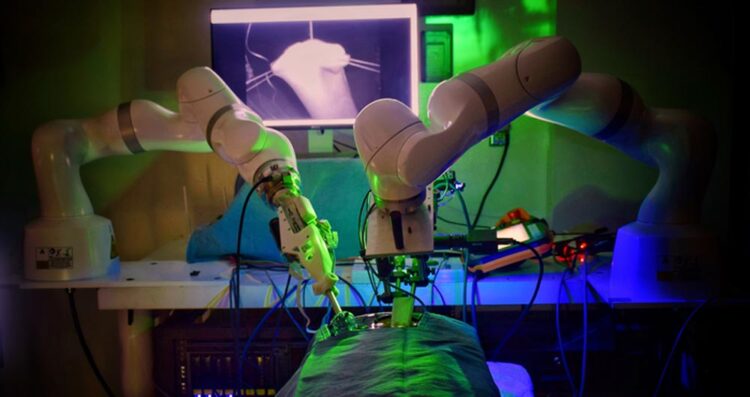Robot performs 1st laparoscopic surgery without human help

The Smart Tissue Autonomous Robot can perform laparoscopic surgery on the soft tissue of a pig without human help.
Credit: Johns Hopkins University
A robot has performed laparoscopic surgery on the soft tissue of a pig without the guiding hand of a human – a significant step in robotics toward fully automated surgery on humans. Designed by a team of Johns Hopkins University researchers, the Smart Tissue Autonomous Robot (STAR) is described today in Science Robotics.
“Our findings show that we can automate one of the most intricate and delicate tasks in surgery: the reconnection of two ends of an intestine. The STAR performed the procedure in four animals and it produced significantly better results than humans performing the same procedure,” said senior author Axel Krieger, an assistant professor of mechanical engineering at Johns Hopkins’ Whiting School of Engineering.
The robot excelled at intestinal anastomosis, a procedure that requires a high level of repetitive motion and precision. Connecting two ends of an intestine is arguably the most challenging step in gastrointestinal surgery, requiring a surgeon to suture with high accuracy and consistency. Even the slightest hand tremor or misplaced stitch can result in a leak that could have catastrophic complications for the patient.
Working with collaborators at the Children’s National Hospital in Washington, D.C. and Jin Kang, a Johns Hopkins professor of electrical and computer engineering, Krieger helped create the robot, a vision-guided system designed specifically to suture soft tissue. Their current iteration advances a 2016 model that repaired a pig’s intestines accurately, but required a large incision to access the intestine and more guidance from humans.
The team equipped the STAR with new features for enhanced autonomy and improved surgical precision, including specialized suturing tools and state-of-the art imaging systems that provide more accurate visualizations of the surgical field.
Soft-tissue surgery is especially hard for robots because of its unpredictability, forcing them to be able to adapt quickly to handle unexpected obstacles, Krieger said. The STAR has a novel control system that can adjust the surgical plan in real time, just as a human surgeon would.
“What makes the STAR special is that it is the first robotic system to plan, adapt, and execute a surgical plan in soft tissue with minimal human intervention,” Krieger said.
A structural-light based three-dimensional endoscope and machine learning-based tracking algorithm developed by Kang and his students guides STAR. “We believe an advanced three-dimensional machine vision system is essential in making intelligent surgical robots smarter and safer,” Kang said.
As the medical field moves towards more laparoscopic approaches for surgeries, it will be important to have an automated robotic system designed for such procedures to assist, Krieger said.
“Robotic anastomosis is one way to ensure that surgical tasks that require high precision and repeatability can be performed with more accuracy and precision in every patient independent of surgeon skill,” Krieger said. “We hypothesize that this will result in a democratized surgical approach to patient care with more predictable and consistent patient outcomes.”
The team from Johns Hopkins also included Hamed Saeidi, Justin D. Opfermann, Michael Kam, Shuwen Wei, and Simon Leonard. Michael H. Hsieh, director of Transitional Urology at Children’s National Hospital, also contributed to the research.
The work was supported by the National Institute of Biomedical Imaging and Bioengineering of the National Institutes of Health under award numbers 1R01EB020610 and R21EB024707.
Journal: Science Robotics
DOI: 10.1126/scirobotics.abj2908
Article Publication Date: 25-Jan-2022
Media Contact
Jill Rosen
Johns Hopkins University
jrosen@jhu.edu
Office: 443-997-9906
Cell: 443-547-8805
All latest news from the category: Medical Engineering
The development of medical equipment, products and technical procedures is characterized by high research and development costs in a variety of fields related to the study of human medicine.
innovations-report provides informative and stimulating reports and articles on topics ranging from imaging processes, cell and tissue techniques, optical techniques, implants, orthopedic aids, clinical and medical office equipment, dialysis systems and x-ray/radiation monitoring devices to endoscopy, ultrasound, surgical techniques, and dental materials.
Newest articles

Properties of new materials for microchips
… can now be measured well. Reseachers of Delft University of Technology demonstrated measuring performance properties of ultrathin silicon membranes. Making ever smaller and more powerful chips requires new ultrathin…

Floating solar’s potential
… to support sustainable development by addressing climate, water, and energy goals holistically. A new study published this week in Nature Energy raises the potential for floating solar photovoltaics (FPV)…

Skyrmions move at record speeds
… a step towards the computing of the future. An international research team led by scientists from the CNRS1 has discovered that the magnetic nanobubbles2 known as skyrmions can be…





















